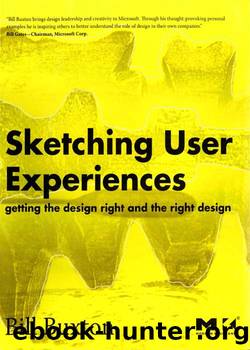Sketching User Experiences by Buxton Bill

Author:Buxton, Bill [Buxton, Bill]
Language: eng
Format: epub
ISBN: 978-0-080-55290-3
Publisher: Elsevier
Published: 2007-11-14T16:00:00+00:00
In the Introduction to this book I said something that read like a paradox:
The only way to engineer the future tomorrow is to have lived in it yesterday.
What Baumâs book teaches us is that if we do an effective job of following the example of the Wizard, we too can conjure up systems that will let users have real and valid experiences, before the system exists in any normal sense of the word. In all of this, the four most important things to glean and carry forward are:
⢠It is fidelity of the experience, not the fidelity of the prototype, sketch, or technology that is important from he perspective of ideation and early design.
⢠We can use anything that we want to conjure up such experiences.
⢠The earlier that we do so the more valuable it generally is.
⢠It is much easier, cheaper, faster, and more reliable to find a little old man, a microphone, and some loud speakers than it is to find a real wizard. So it is with most systems. Fake it before you build it.
Iâm not sure who first used the term âWizard of Ozâ in the context of interaction design. I first heard it from one of my early influences, John Gould, of IBM. But regardless of who coined the term, the meaning is pretty well understood internationally (unlike the story): the Wizard of Oz Technique involves making a working system, where the person using it is unaware that some or all of the systemâs functions are actually being performed by a human operator, hidden somewhere âbehind the screen.â
The objective is not to make the actual system, but to mock up something that users can actually experience, thereby enabling us to explore design concepts in action and as experienced far earlier in the process than would otherwise be possible. Such a system should be cheap, quick to realize, disposable, not the real thing, and only have sufficient fidelity to serve its intended purpose. That is, it should have all the attributes that characterize a sketch.
Inherent in all this is the following rule:
Generally the last thing that you should do when beginning to design an interactive system is write code.
Download
This site does not store any files on its server. We only index and link to content provided by other sites. Please contact the content providers to delete copyright contents if any and email us, we'll remove relevant links or contents immediately.
| Automotive | Engineering |
| Transportation |
Whiskies Galore by Ian Buxton(40332)
Introduction to Aircraft Design (Cambridge Aerospace Series) by John P. Fielding(32338)
Small Unmanned Fixed-wing Aircraft Design by Andrew J. Keane Andras Sobester James P. Scanlan & András Sóbester & James P. Scanlan(32141)
Craft Beer for the Homebrewer by Michael Agnew(17446)
Turbulence by E. J. Noyes(7039)
The Complete Stick Figure Physics Tutorials by Allen Sarah(6638)
Kaplan MCAT General Chemistry Review by Kaplan(6054)
The Thirst by Nesbo Jo(5785)
Bad Blood by John Carreyrou(5769)
Learning SQL by Alan Beaulieu(5412)
Weapons of Math Destruction by Cathy O'Neil(5037)
Man-made Catastrophes and Risk Information Concealment by Dmitry Chernov & Didier Sornette(4736)
iGen by Jean M. Twenge(4702)
Digital Minimalism by Cal Newport;(4542)
Life 3.0: Being Human in the Age of Artificial Intelligence by Tegmark Max(4508)
Audition by Ryu Murakami(4099)
1,001 ASVAB Practice Questions For Dummies by Powers Rod(4039)
Electronic Devices & Circuits by Jacob Millman & Christos C. Halkias(4029)
Pale Blue Dot by Carl Sagan(4001)
